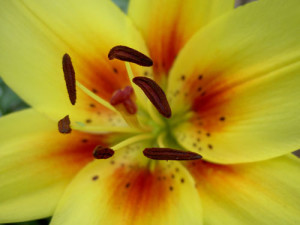Looking for information about the importance of honey bees can lead to learn that honey bees are important pollinators. However, what is pollination?
A definition I have found to be interesting was mentioned in a document on the Food and Agriculture Organization of the United Nations’ website, fao.org. The definition is the following:
Pollination is transfer of pollen from the anther (the male part of the flower) to the stigma (the female part of the flower). Some plants can pollinate themselves: in this case, the pollen passes from the anther to the stigma inside the same flower, and this is called self-pollination. Other plants need pollen to be transferred between different flowers or different individuals of the plant. This is cross-pollination.
Many plants can be pollinated both ways. Plants can be pollinated by wind or animals.
This being, we can appreciate more the importance of honey bees when we take into consideration the fact that a lot of the food we eat results from their pollination.
As the definition for the term pollination noted, some plants need to be pollinated by animals. Effectively, billions of dollars of food produced yearly in Arizona benefits from the work of honey bees. Accordingly, a document on the University of Arizona’s website states the following:
Some plants, for example grasses, produce light pollen grains that may be carried by the wind or water from plant to plant. Other plants need help from insects, birds, or bats for successful pollination. Without this assistance, fruit and/or seeds would not be formed. In fact, about a third of the food Americans eat is the direct result of pollination by insects.
More than 100 agricultural crops in the United States are pollinated by bees. This means bees are important, if not essential, for the production of nearly $7 billion worth of agricultural crops produced annually in Arizona. Examples of bee pollinated crops include watermelons, cantaloupe, citrus and apples (see story below).
The situation is such that it is not only flowers that profit from bees but also human beings and animals. Nonetheless, because the idea of honey bees pollinating food crops could more understood with a practical example, the next lines from the University of Arizona’s site could help a person better grasp how essential honey bees are to the production of apples:
Did you ever wonder where apples come from or how an apple tree makes apples? Actually, apples start as flowers on the apple tree. Without the help of bees though, the flowers would bloom and then wither and drop without ever having a chance to become an apple. For a flower to become an apple, the pollen that is produced by the flowers on one apple tree must be transferred to the flowers on another tree. The pollen is moved between trees by bees who visit the flowers to collect nectar and pollen. Moving pollen between flowers is called cross-pollination.
It is important that the lives of honey bees be protected. However, I believe that it is vital that the world come back to a more natural way of life.
If you would like to have 10 free lessons about beekeeping, I invite you to Click Here to go signup at: .

